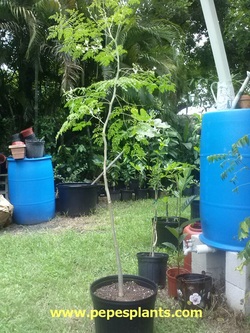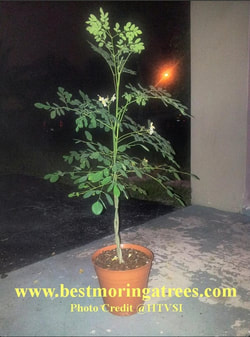Growing Moringa oleifera in containers

This tree was seed grown.
Not the one described here.
A few years ago I discovered the amazing Moringa oleifera tree. It was quite a sight to see. The tree was almost nine foot tall and growing in a 3 gal plastic nursery container. A tree that large was way too big for a 10 inch diameter container. The trees roots had split the pot and were totally twisted, circling and thick. I usually have a cell phone in one hand but unfortunately not on this day. Sorry no photo to share with you of that mass of roots. This was not an ideal situation for that tree to be growing in. How could this tree survive in such a tight space? Would this tree make sense to buy and bring back to my nursery?
Well, nevertheless, I purchased that nine foot tree and transplanted it. I took my nice sharp clean pruner and went to work on the thick mass of roots. I honestly performed some serious surgery and left only the thick tuberous root.
Now this is important! When you plan on growing your tree in a container be certain to cut the main tap root. The tap root runs deep into the soil in search of water. Before you plant that tree cut that tap root. By cutting the root you stimulate vigorous lateral but shallow root growth. This root growth is better suited for container growing. Moringa trees planted without a pruned tap root perform poorly in containers.
Next I planted the tree in a seven gal plastic pot with a professional soil less potting mix. These mixes provide a sterile medium and also drain well but still maintain adequate air and moisture. I pruned the main trunk to about a height of five feet and watered the container lightly with just good old rain water.
The next step was to move the newly planted tree to a bright location out of direct sunlight. I did not need to water the tree again except on a few occasions all summer long. Here in Florida our summer is the rainy season.
After about six weeks I began to move the tree out towards more sunlight gradually to acclimate it to the hot sun. By summers end that tree was rooted very well and had grown five foot taller.
The Moringa oleifera tree does not need heavy amounts of fertilizer. I only fertilized the tree with yard and kitchen compost, worm compost tea and some occasional fish emulsion and some trace minerals.
Now I enjoy growing the majority of my Moringa trees in containers. I have found them to grow well in both plastic containers and grow bags like Geopots.
Growing Moringa trees in containers is easy so long as you keep the soil moist (not soaked with water) and allow it to dry out a little once a week.
These trees have not had any major issues with insects or diseases. The largest trees I have are twelve footers with six inch calipers and are growing in 25 gal containers. You can do the same by root pruning on an annual basis and following the directions provided here. No need to plant them in the ground. Harvest them often and use the leaves, pods and seeds to stay healthy by adding them to your diet.
I enjoy drying the leaves and preparing tea. Moringa can be cooked like spinach and the seeds have been used to purify water. Many people prepare and also eat the root, but this I can't recommend. Moringa oleifera is powerful nutrition and it is considered an incredible medicinal plant by people world wide.
Well, nevertheless, I purchased that nine foot tree and transplanted it. I took my nice sharp clean pruner and went to work on the thick mass of roots. I honestly performed some serious surgery and left only the thick tuberous root.
Now this is important! When you plan on growing your tree in a container be certain to cut the main tap root. The tap root runs deep into the soil in search of water. Before you plant that tree cut that tap root. By cutting the root you stimulate vigorous lateral but shallow root growth. This root growth is better suited for container growing. Moringa trees planted without a pruned tap root perform poorly in containers.
Next I planted the tree in a seven gal plastic pot with a professional soil less potting mix. These mixes provide a sterile medium and also drain well but still maintain adequate air and moisture. I pruned the main trunk to about a height of five feet and watered the container lightly with just good old rain water.
The next step was to move the newly planted tree to a bright location out of direct sunlight. I did not need to water the tree again except on a few occasions all summer long. Here in Florida our summer is the rainy season.
After about six weeks I began to move the tree out towards more sunlight gradually to acclimate it to the hot sun. By summers end that tree was rooted very well and had grown five foot taller.
The Moringa oleifera tree does not need heavy amounts of fertilizer. I only fertilized the tree with yard and kitchen compost, worm compost tea and some occasional fish emulsion and some trace minerals.
Now I enjoy growing the majority of my Moringa trees in containers. I have found them to grow well in both plastic containers and grow bags like Geopots.
Growing Moringa trees in containers is easy so long as you keep the soil moist (not soaked with water) and allow it to dry out a little once a week.
These trees have not had any major issues with insects or diseases. The largest trees I have are twelve footers with six inch calipers and are growing in 25 gal containers. You can do the same by root pruning on an annual basis and following the directions provided here. No need to plant them in the ground. Harvest them often and use the leaves, pods and seeds to stay healthy by adding them to your diet.
I enjoy drying the leaves and preparing tea. Moringa can be cooked like spinach and the seeds have been used to purify water. Many people prepare and also eat the root, but this I can't recommend. Moringa oleifera is powerful nutrition and it is considered an incredible medicinal plant by people world wide.

